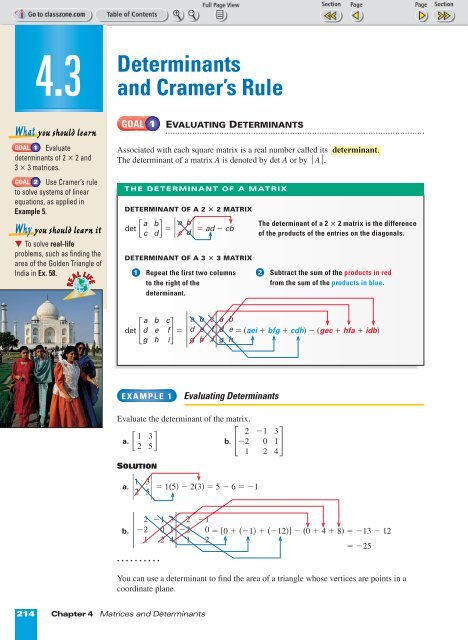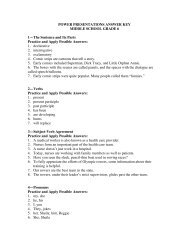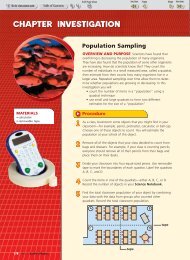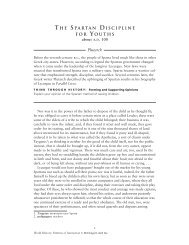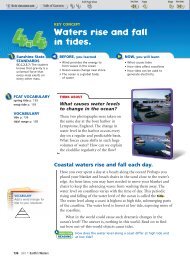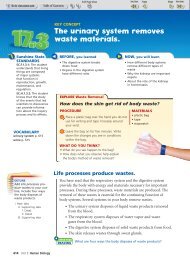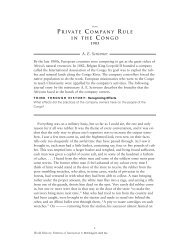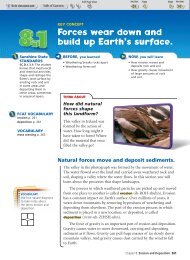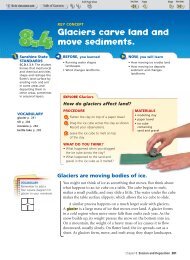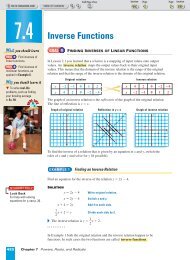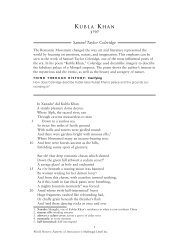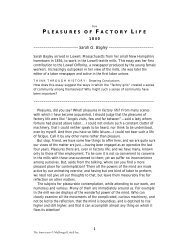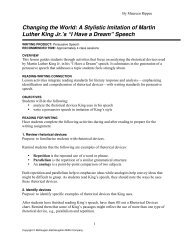Determinants and Cramer's Rule - ClassZone
Determinants and Cramer's Rule - ClassZone
Determinants and Cramer's Rule - ClassZone
You also want an ePaper? Increase the reach of your titles
YUMPU automatically turns print PDFs into web optimized ePapers that Google loves.
4.3<br />
What you should learn<br />
GOAL 1 Evaluate<br />
determinants of 2 ª 2 <strong>and</strong><br />
3 ª 3 matrices.<br />
GOAL 2 Use Cramer’s rule<br />
to solve systems of linear<br />
equations, as applied in<br />
Example 5.<br />
Why you should learn it<br />
To solve real-life<br />
problems, such as finding the<br />
area of the Golden Triangle of<br />
India in Ex. 58.<br />
REAL<br />
REAL LIFE<br />
LIFE<br />
<strong>Determinants</strong><br />
<strong>and</strong> Cramer’s <strong>Rule</strong><br />
GOAL 1<br />
EVALUATING DETERMINANTS<br />
Associated with each square matrix is a real number called its<br />
The determinant of a matrix A is denoted by det A or by |A|.<br />
DETERMINANT OF A 2 ª 2 MATRIX<br />
a<br />
det c b a =<br />
d c b<br />
d<br />
= ad º cb<br />
DETERMINANT OF A 3 ª 3 MATRIX<br />
det = a b c<br />
d e f<br />
g h i<br />
EXAMPLE 1<br />
Evaluating <strong>Determinants</strong><br />
Evaluate the determinant of the matrix.<br />
a. 2<br />
1 3<br />
b. º2<br />
2 5<br />
1<br />
SOLUTION<br />
1 3<br />
a. 25 2<br />
b. º2<br />
1<br />
. . . . . . . . . .<br />
= 1(5) º 2(3) = 5 º 6 = º1<br />
º1<br />
0<br />
2<br />
=<br />
214 Chapter 4 Matrices <strong>and</strong> <strong>Determinants</strong><br />
THE DETERMINANT OF A MATRIX<br />
1<br />
Repeat the first two columns<br />
to the right of the<br />
determinant.<br />
a b c a<br />
d e f d<br />
g h i g<br />
b<br />
e<br />
h<br />
2<br />
º1 3<br />
0 1<br />
Page 1 of 2<br />
3 2 º1<br />
1 º2 0 = [0 + (º1) + (º12)] º (0 + 4 + 8) = º13 º 12<br />
4 1 2<br />
= º25<br />
You can use a determinant to find the area of a triangle whose vertices are points in a<br />
coordinate plane.<br />
2<br />
4<br />
determinant.<br />
The determinant of a 2 ª 2 matrix is the difference<br />
of the products of the entries on the diagonals.<br />
Subtract the sum of the products in red<br />
from the sum of the products in blue.<br />
(aei + bfg + cdh) º (gec + hfa + idb)
FOCUS ON<br />
APPLICATIONS<br />
BERMUDA<br />
TRIANGLE<br />
The U.S.S. Cyclops, shown<br />
above, disappeared in the<br />
Bermuda Triangle in March,<br />
1918.<br />
LIFE<br />
LIFE<br />
REAL<br />
REAL<br />
AREA OF A TRIANGLE<br />
The area of a triangle with vertices<br />
(x 1, y 1), (x 2, y 2), <strong>and</strong> (x 3, y 3) is given by<br />
Area = ± 1<br />
2 <br />
EXAMPLE 2<br />
The Area of a Triangle<br />
The area of the triangle shown is:<br />
Area = ± 1<br />
EXAMPLE 3<br />
2 <br />
1 2 1<br />
4 0 1<br />
6 2 1<br />
= ± 1<br />
[(0 + 12 + 8)º (0 + 2 + 8)] = 5<br />
2<br />
The Area of a Triangular Region<br />
BERMUDA TRIANGLE The Bermuda<br />
Triangle is a large triangular region in the<br />
Atlantic Ocean. Many ships <strong>and</strong> airplanes<br />
have been lost in this region. The triangle<br />
is formed by imaginary lines connecting<br />
Bermuda, Puerto Rico, <strong>and</strong> Miami,<br />
Florida. Use a determinant to estimate<br />
the area of the Bermuda Triangle.<br />
Page 1 of 2<br />
SOLUTION<br />
The approximate coordinates of the Bermuda Triangle’s three vertices are<br />
(938, 454), (900, º518), <strong>and</strong> (0, 0). So, the area of the region is as follows:<br />
Area = ± 1<br />
<br />
x1 y1 x2 y2 x3 y3 1<br />
1<br />
1<br />
where the symbol ± indicates that the<br />
appropriate sign should be chosen to<br />
yield a positive value.<br />
2 <br />
938 454 1<br />
<br />
900 º518 1<br />
0 0 1<br />
= ± 1<br />
[(º485,884 + 0 + 0) º (0 + 0 + 408,600)]<br />
2<br />
= 447,242<br />
The area of the Bermuda Triangle is about 447,000 square miles.<br />
W<br />
y<br />
(x 3, y 3)<br />
1<br />
y<br />
(1, 2) (6, 2)<br />
1<br />
Miami (0, 0)<br />
Each tick mark<br />
represents 200 mi.<br />
(x 1, y 1)<br />
N<br />
S<br />
(4, 0)<br />
(x 2, y 2)<br />
4.3 <strong>Determinants</strong> <strong>and</strong> <strong>Cramer's</strong> <strong>Rule</strong> 215<br />
x<br />
x<br />
Bermuda<br />
(938, 454)<br />
Puerto Rico<br />
(900, 518)<br />
E
STUDENT HELP<br />
HOMEWORK HELP<br />
Visit our Web site<br />
www.mcdougallittell.com<br />
for extra examples.<br />
INTERNET<br />
GOAL 2<br />
2 5 <br />
216 Chapter 4 Matrices <strong>and</strong> <strong>Determinants</strong><br />
USING CRAMER’S RULE<br />
º10 º4 º8 º ( º50) 42<br />
x = = = = º1<br />
º42 º42<br />
º 42<br />
Page 1 of 2<br />
You can use determinants to solve a system of linear equations. The method,<br />
called Cramer’s rule <strong>and</strong> named after the Swiss mathematician Gabriel Cramer<br />
(1704º1752), uses the coefficient matrix of the linear system.<br />
LINEAR SYSTEM COEFFICIENT MATRIX<br />
ax + by = e<br />
cx + dy = f<br />
In Cramer’s rule, notice that the denominator for x <strong>and</strong> y is the determinant of the<br />
coefficient matrix of the system. The numerators for x <strong>and</strong> y are the determinants<br />
of the matrices formed by using the column of constants as replacements for the<br />
coefficients of x <strong>and</strong> y, respectively.<br />
EXAMPLE 4<br />
Using Cramer’s <strong>Rule</strong> for a 22 System<br />
Use Cramer’s rule to solve this system:<br />
SOLUTION<br />
Evaluate the determinant of the coefficient matrix.<br />
8 5<br />
<br />
2<br />
º4<br />
= º32 º 10 = º42<br />
Apply Cramer’s rule since the determinant is not 0.<br />
y = = <br />
º42 º80<br />
º 4<br />
= <br />
º 42<br />
º<br />
8 2<br />
2 º10<br />
84<br />
= 2<br />
º 42<br />
The solution is (º1, 2).<br />
a b <br />
CRAMER’S RULE FOR A 2 X 2 SYSTEM<br />
Let A be the coefficient matrix of this linear system:<br />
ax + by = e<br />
cx + dy = f<br />
If det A ≠ 0, then the system has exactly one solution. The solution is:<br />
<br />
f <br />
e b<br />
a e<br />
d<br />
c f<br />
x = <strong>and</strong> y = det A det A<br />
8x + 5y = 2<br />
2x º 4y = º10<br />
✓CHECK Check this solution 8(º1) + 5(2)· 2 2(º1) º 4(2)· º10<br />
in the original equations. 2 = 2 ✓ º10 = º10 ✓<br />
c<br />
d
CHEMIST<br />
Chemists research<br />
<strong>and</strong> put to practical use<br />
knowledge about chemicals.<br />
Research on the chemistry of<br />
living things sparks advances<br />
in medicine, agriculture, <strong>and</strong><br />
other fields.<br />
CAREER LINK<br />
www.mcdougallittell.com<br />
REAL<br />
REAL LIFE<br />
LIFE<br />
INTERNET<br />
FOCUS ON<br />
CAREERS<br />
CRAMER’S RULE FOR A 3 X 3 SYSTEM<br />
Let A be the coefficient matrix of this linear system:<br />
EXAMPLE 5<br />
Using Cramer’s <strong>Rule</strong> for a 3 ª3 System<br />
SCIENCE CONNECTION The atomic<br />
weights of three compounds are shown.<br />
Use a linear system <strong>and</strong> Cramer’s rule to<br />
find the atomic weights of carbon (C),<br />
hydrogen (H), <strong>and</strong> oxygen (O).<br />
Page 1 of 2<br />
SOLUTION<br />
Write a linear system using the formula for each compound. Let C, H, <strong>and</strong> O<br />
represent the atomic weights of carbon, hydrogen, <strong>and</strong> oxygen.<br />
C + 4H = 16<br />
3C + 8H + 3O = 92<br />
2H + O = 18<br />
Evaluate the determinant of the coefficient matrix.<br />
1 4 0<br />
3 8 3 <br />
0<br />
2<br />
1<br />
ax + by + cz = j<br />
dx + ey + fz = k<br />
gx + hy + iz = l<br />
If det A ≠ 0, then the system has exactly one solution. The solution is:<br />
l g <br />
j b c<br />
a j c<br />
a b j<br />
k e f<br />
d k f<br />
d e k<br />
h i<br />
x = , det A<br />
l i<br />
y = , det A<br />
<strong>and</strong><br />
g h l<br />
z = det A<br />
= (8 + 0 + 0) º (0 + 6 + 12) = º10<br />
Apply Cramer’s rule since the determinant is not 0.<br />
C = = <br />
º10 º<br />
16 4 0<br />
92 8 3 18<br />
2 1 120<br />
= 12 Atomic weight of carbon<br />
º 10<br />
<br />
H = = <br />
º10 º<br />
1 16 0<br />
3 92 3<br />
0 18 1 10<br />
= 1<br />
º 10<br />
Atomic weight of hydrogen<br />
<br />
O = = <br />
º10 º<br />
1 4 16<br />
3 8 92<br />
0 2 18 160<br />
= 16<br />
º 10<br />
Atomic weight of oxygen<br />
Compound Formula Atomic weight<br />
Methane CH 4 16<br />
Glycerol C 3 H 8 O 3 92<br />
Water H 2 O 18<br />
The weights of carbon, hydrogen, <strong>and</strong> oxygen are 12, 1, <strong>and</strong> 16, respectively.<br />
4.3 <strong>Determinants</strong> <strong>and</strong> <strong>Cramer's</strong> <strong>Rule</strong> 217
GUIDED PRACTICE<br />
Vocabulary Check ✓<br />
Concept Check ✓<br />
Skill Check ✓<br />
1. Explain Cramer’s rule <strong>and</strong> how it is used.<br />
Page 1 of 2<br />
2. Can two different matrices have the same determinant? If so, give an example.<br />
3. ERROR ANALYSIS Find the error in each calculation.<br />
a. b.<br />
= 6 º 5 = 1 3<br />
5<br />
º1<br />
2<br />
4<br />
º1 2<br />
3<br />
=º2 º 12 = º14<br />
4. To use Cramer’s rule to solve a linear system, what must be true of the<br />
determinant of the coefficient matrix?<br />
Evaluate the determinant of the matrix.<br />
PRACTICE AND APPLICATIONS<br />
STUDENT HELP<br />
Extra Practice<br />
to help you master<br />
skills is on p. 945.<br />
STUDENT HELP<br />
HOMEWORK HELP<br />
Example 1: Exs. 12–29<br />
Example 2: Exs. 30–35<br />
Example 3: Exs. 54–58<br />
Example 4: Exs. 36–44,<br />
59<br />
Example 5: Exs. 45–53,<br />
60<br />
0 1<br />
º1 4<br />
8 º2<br />
5. 6. 7. <br />
6<br />
Use Cramer’s rule to solve the linear system.<br />
8. 6x º 8y = 4 9. 2x +7y = º3 10. 12x º 2y = 2<br />
4x º 5y = º4 3x º 8y = º23 º14x +11y = 51<br />
11. SCHOOL SPIRIT You are making a<br />
large pennant for your school football team.<br />
A diagram of the pennant is shown at the<br />
right. The coordinates given are measured in<br />
inches. How many square inches of material<br />
will you need to make the pennant?<br />
2 ª 2 DETERMINANTS Evaluate the determinant of the matrix.<br />
º4 2<br />
8 0<br />
9 3<br />
12. 13. 14.<br />
5 º2<br />
º1 3 º2 1<br />
º7 11<br />
4 0<br />
1 8<br />
15. 16. 17.<br />
º7 2<br />
º3 4 59 º6 5<br />
0 º3<br />
12 2<br />
18. 19. 20. <br />
º3<br />
218 Chapter 4 Matrices <strong>and</strong> <strong>Determinants</strong><br />
2<br />
9<br />
8<br />
3 ª 3 DETERMINANTS Evaluate the determinant of the matrix.<br />
12<br />
21.º2 5<br />
4<br />
3<br />
8 º1<br />
2<br />
1<br />
5<br />
22.4 0<br />
º9<br />
2<br />
1 4<br />
1<br />
1<br />
0<br />
23.10 º5<br />
5<br />
13<br />
4<br />
1<br />
24.20 7<br />
16<br />
4<br />
1 º2<br />
2<br />
º4<br />
º4<br />
25. 0<br />
0<br />
0<br />
8<br />
5 º1<br />
9<br />
2<br />
8<br />
26.12 3<br />
2<br />
3<br />
13<br />
3<br />
27. 10<br />
º5<br />
12<br />
9<br />
6 º1<br />
0<br />
º2<br />
º3<br />
28.º10 11<br />
2<br />
9<br />
15 20<br />
18<br />
12<br />
15<br />
29.º10 º8<br />
4<br />
0<br />
2<br />
5<br />
º1<br />
10<br />
10<br />
º2<br />
y<br />
(0, 50)<br />
GO TEAM<br />
(0, 0)<br />
º5<br />
40<br />
8<br />
4<br />
2<br />
º4<br />
º1<br />
9<br />
9<br />
4<br />
º10<br />
6<br />
º14<br />
(70, 20)<br />
x
FOCUS ON<br />
APPLICATIONS<br />
SAILING The<br />
edges of a sail are<br />
called the luff, leech, <strong>and</strong><br />
foot. The luff length of the jib<br />
is usually 80% to 90% of the<br />
distance from the deck to<br />
the head of the jib.<br />
LIFE<br />
LIFE<br />
REAL<br />
REAL<br />
leech luff<br />
foot mainsail jib<br />
head<br />
Page 1 of 2<br />
AREA OF A TRIANGLE Find the area of the triangle with the given vertices.<br />
30. A(0, 1), B(2, 7), C(5, 5) 31. A(3, 6), B(3, 0), C(1, 3)<br />
32. A(6, º1), B(2, 2), C(4, 8) 33. A(º4, 2), B(3, º1), C(º2, º2)<br />
34. A(2, º6), B(º1, º4), C(0, 2) 35. A(1, 3), B(º2, 6), C(º1, 1)<br />
USING CRAMER’S RULE Use Cramer’s rule to solve the linear system.<br />
36. 2x + y = 3 37. 7x º 5y = 11 38. 9x + 2y = 7<br />
5x + 6y = 4 3x + 10y = º56 4x º 3y = 42<br />
39. x + 7y = º3 40. ºx º 12y = 44 41. 4x º 3y = 18<br />
3x º 5y = 17 12x º 15y = º51 8x º 7y = 34<br />
42. 4x º 5y = 13 43. 8x º 9y = 32 44. 3x + 10y = 50<br />
2x º 7y = 24 º5x + 7y = 40 12x + 15y = 64<br />
SOLVING SYSTEMS Use Cramer’s rule to solve the linear system.<br />
45. x + 2y º 3z = º2 46. x + 3y º z = 1 47. 3x + 2y º 5z = º10<br />
x º y + z = º1 º2x º 6y + z = º3 6x º z = 8<br />
3x + 4y º 4z = 4 3x + 5y º 2z = 4 ºy + 3z = º2<br />
48. x + 2y + z = 9 49. 4x + y + 6z = 7 50. x + 4y º z = º7<br />
x + y + z = 3 3x + 3y + 2z = 17 2x º y + 2z = 15<br />
5x º 2z = º1 ºx º y + z = º9 º3x + y º 3z = º22<br />
51. 2x + y + z = 5 52. ºx + 2y + 7z = 13 53. º3x + y +2z = º14<br />
x +4y º 2z = 9 2x º y º 2z = º2 9x º y + 2z = º8<br />
6x + 5y = 16 3x + 5y + 2z = º14 8x +5y º 4z = 6<br />
54. BIRDS Black-necked stilts<br />
are birds that live throughout<br />
Florida <strong>and</strong> surrounding areas<br />
but breed mostly in the triangular<br />
region shown on the map.<br />
Estimate the area of this region.<br />
The coordinates given are<br />
measured in miles.<br />
SAILING In Exercises 55–57,<br />
use the following information.<br />
On a Marconi-rigged sloop, there<br />
are two triangular sails, a mainsail<br />
<strong>and</strong> a jib. These sails are shown in a<br />
coordinate plane at the right. The<br />
coordinates in the plane are measured<br />
in feet.<br />
55. Find the area of the mainsail shown.<br />
56. Find the area of the jib shown.<br />
57. Suppose you are making a scale model<br />
of the sailboat with the sails shown<br />
using a scale of l in. = 6 ft. What is the<br />
area of the model’s mainsail?<br />
Each tick mark<br />
represents 50 miles.<br />
26 y<br />
18<br />
2<br />
2<br />
W<br />
12 14<br />
(0, 0)<br />
mainsail jib<br />
(35, 220)<br />
4.3 <strong>Determinants</strong> <strong>and</strong> <strong>Cramer's</strong> <strong>Rule</strong> 219<br />
N<br />
S<br />
22<br />
(112, 56)<br />
x<br />
E
Test<br />
Preparation<br />
★ Challenge<br />
EXTRA CHALLENGE<br />
www.mcdougallittell.com<br />
58. SOCIAL STUDIES CONNECTION The Golden<br />
Triangle refers to a large triangular region<br />
in India. The Taj Mahal is one of the many<br />
wonders that lie within the boundaries of<br />
this triangle. The triangle is formed by<br />
imaginary lines that connect the cities of<br />
New Delhi, Jaipur, <strong>and</strong> Agra. Use the<br />
coordinates on the map <strong>and</strong> a determinant<br />
to estimate the area of the Golden Triangle.<br />
The coordinates given are measured in miles.<br />
Page 1 of 2<br />
59. BUYING GASOLINE You fill up your car with 10 gallons of premium<br />
gasoline <strong>and</strong> fill a small gas can with 2 gallons of regular gasoline for your lawn<br />
mower. You pay the cashier $13.56. The price of premium gasoline is 12 cents<br />
more per gallon than the price of regular gasoline. Use a linear system <strong>and</strong><br />
Cramer’s rule to find the price per gallon for regular <strong>and</strong> premium gasoline.<br />
60. SCIENCE CONNECTION The atomic weights of three compounds are shown.<br />
Use a linear system <strong>and</strong> Cramer’s rule to find the atomic weights of sulphur (S),<br />
nitrogen (N), <strong>and</strong> flourine (F).<br />
61. LOGICAL REASONING Explain what happens to the determinant of a matrix<br />
when you switch two rows or two columns.<br />
QUANTITATIVE COMPARISON In Exercises 62 <strong>and</strong> 63, choose the statement<br />
that is true about the given quantities.<br />
62.<br />
63.<br />
¡ A The quantity in column A is greater.<br />
¡ B The quantity in column B is greater.<br />
220 Chapter 4 Matrices <strong>and</strong> <strong>Determinants</strong><br />
Compound Formula Atomic weight<br />
Tetrasulphur tetranitride S 4 N 4 184<br />
Sulphur hexaflouride SF 6 146<br />
Dinitrogen tetraflouride N 2 F 4 104<br />
¡ C The two quantities are equal.<br />
¡ D The relationship cannot be determined from the given information.<br />
Column A Column B<br />
The area of a triangle with vertices The area of a triangle with vertices<br />
(º3, 4), (4, 2), <strong>and</strong> (1, º2) (4, 2), (1, º2), <strong>and</strong> (3, º4)<br />
det det 1<br />
º5 6<br />
º7<br />
º2<br />
10<br />
2 º1<br />
3 5<br />
64. DETERMINANT RELATIONSHIPS Let A = <strong>and</strong> B =<br />
3 2 º2 º4.<br />
a. How is det AB related to det A <strong>and</strong> det B?<br />
b. How is det kA related to det A if k is a constant? Check your answer using<br />
matrix B <strong>and</strong> several other 2 ª 2 matrices.<br />
W<br />
N<br />
S<br />
Jaipur<br />
(0, 0)<br />
New Delhi<br />
(100, 120)<br />
Each tick mark<br />
represents 20 miles.<br />
3<br />
5<br />
Agra<br />
(140, 20)<br />
E
MIXED REVIEW<br />
Page 1 of 2<br />
EVALUATING FUNCTIONS Find the indicated value of ƒ(x). (Review 2.1)<br />
65. ƒ(x) = x º 10, f(7) 66. ƒ(x) = 3x + 7, ƒ(º2)<br />
67. ƒ(x) = ºx 2 + 5, ƒ(º1) 68. ƒ(x) = x 2 º 2x º 4, ƒ(7)<br />
69. ƒ(x) = x 2 + 4x º 1, ƒ 1<br />
2 70. ƒ(x) = x 5 º 2x º 10, ƒ(3)<br />
GRAPHING SYSTEMS Graph the system of linear inequalities. (Review 3.3)<br />
71. x < 3 72. y ≥ 2x º 3 73. y > ºx º 5<br />
x > º2 y > º5x º 8 y > 3x +1<br />
74. x + y > 3 75. 2x º y ≥ 2 76. 4x º 3y > 1<br />
4x + y < 4 5x º y ≥ 2 ºx + y ≥ 4<br />
MULTIPLYING MATRICES Find the product. (Review 4.2 for 4.4)<br />
º2 º4 6 º1 7 º1 0 º3 11 º2 º8 3<br />
77. 78. 79.<br />
5 1 3 º3 4 º10 4 8 0 4<br />
8 º1<br />
3 º5 10 9 0.5 3 0 0.6<br />
º2 1.3 1.6 6<br />
80. 81. 82. <br />
º7<br />
QUIZ 1 Self-Test for Lessons 4.1–4.3<br />
Perform the indicated operation(s). (Lessons 4.1, 4.2)<br />
º2 5 10 º3 º1 5 º8 0 º3 7<br />
1. + 2. º <br />
4<br />
2<br />
º6<br />
12<br />
8<br />
16<br />
º2<br />
º8<br />
º7<br />
3. º2 + 2 4. º 4 7<br />
4<br />
º2 6<br />
9 º5<br />
º3<br />
3<br />
4<br />
3<br />
9<br />
º6<br />
6<br />
º4<br />
10 2<br />
0 0<br />
5 º2<br />
º1<br />
6<br />
0 º3<br />
º5<br />
1<br />
8<br />
5. 6 º1 3<br />
º2º2<br />
7<br />
0<br />
2<br />
6. 2 º1<br />
4 1 3<br />
9<br />
0 0<br />
º3<br />
Evaluate the determinant of the matrix. (Lesson 4.3)<br />
º4<br />
7. º6 3<br />
2<br />
9<br />
8. 6 º3<br />
º2<br />
º1 9. 5<br />
6<br />
2<br />
0<br />
8 3<br />
º2 10.<br />
1<br />
0.2<br />
Use Cramer’s rule to solve the linear system. (Lesson 4.3)<br />
<br />
12 5 º6<br />
2 2 3<br />
11. º8x + y = º6 12. 3x º2y = 10 13. 5x + 4y = 12<br />
º5x +4y = 3 º6x + y = º7 3x º 6y = 3<br />
1<br />
14. 4x + y +6z = 2 15. x + y + 4z = 7 16. 3x + 3y º 2z = º18<br />
2x +2y +4z = 1 2x º 3y º z = º24 º5x º 2y º 3z = º1<br />
ºx º y + z = º5 º4x + 2y + 2z = 8 7x + y + 6z = 14<br />
17. GARDENING You are planning to turn a triangular region of your yard into<br />
a garden. The vertices of the triangle are (0, 0), (5, 2), <strong>and</strong> (3, 6) where the<br />
coordinates are measured in feet. Find the area of the triangular region. (Lesson 4.3)<br />
4<br />
0.8<br />
5<br />
º2<br />
º6<br />
º3<br />
4.3 <strong>Determinants</strong> <strong>and</strong> <strong>Cramer's</strong> <strong>Rule</strong> 221<br />
4<br />
1.5<br />
5<br />
º3<br />
º1<br />
1<br />
º4<br />
0<br />
1.9


